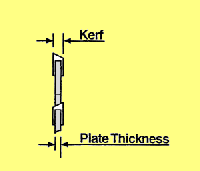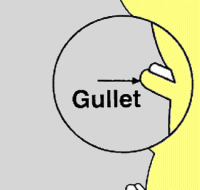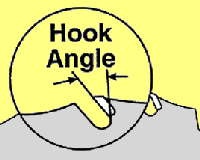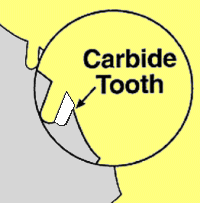Saw Blade Components
Saw Plate
The body, which is obviously the backbone of the blade, is made from a high carbon, chrome, nickel and special moly-alloy steel. The steel will add durability by preventing warping during heat buildup and strength by absorbing initial shock pressure when cutting hard materials. Our plate tolerance is kept to less than .003 inches. Plate tolerance (side to side wobble) or "run out" of the saw blade is a key test of quality. If the plate tolerance is not kept within certain specifications, it may affect the grinding of the carbide tip or "high speed flutter" more commonly known as saw blade noise. Plate tolerance is a key factor to extremely smooth cutting in a very quiet environment.
Kerf
The width of the carbide tip measured from the two widest points of the top of the carbide tip. The kerf on a carbide tipped saw blade acts as the set in the blade giving it the clearance it needs to cut through the material
Kerf and Plate Thickness
Kerf determines the width of the cut and plate thickness determines the amount of relief between the material and the blade.

Arbor Hole
The center bore joins the saw blade with the saw. Its function is critical, for no matter how good a saw blade or saw is, if the arbor fit is not exact, neither will function at maximum efficiency. We use hand tested meters and gauges to assure the exact diameter arbor.
Diameter
The diameter is measured from the furthest edge of one tip to the furthest edge of the tip directly opposite. Generally speaking, the larger diameter blades are thought of as industrial quality for two reasons: 1) a larger diameter can facilitate more teeth for a smoother cut and 2) with a larger diameter, each tooth will have to work less and the blade will last longer as a result. We manufacture blades which range in diameter from 3-3/8" up to 18".
Gauge
The measurement of the plate thickness. Generally, a heavier plate will be stronger and more durable. The gauge goes hand in hand with the steel saw body in that a heavier plate will absorb the initial impact of the cutting edge better than a thinner plate. CAUTION: Too heavy of a plate must also be considered, as some saw machines have reduced horsepower for economical purposes and a heavy plate may tend to drag on the motor.
Shoulder
The shoulder's major functions are to add strength and support to the carbide tip. A well-designed shoulder will help strengthen and guide the carbide tip through the material being cut. Its design must be considered in conjunction with the number of teeth, hook angle, and gullet. A larger diameter blade can easily facilitate 60 to 100 teeth without sacrificing a strong shoulder design.
Gullets
The main purpose of a gullet is to provide clearance for the material being removed. The design of the gullet must be done keeping in mind such factors as material being cut, type of cut (rip or crosscut and smooth or rough), speed of the cut, type of tooth design and pitch or hook angle of the teeth. For example, a Rip saw blade is designed to cut very quickly along the grain of the wood. It has fewer teeth and a large gullet to aid in the removal of sawdust. By contrast, a Crosscut blade will have a smoother, slower cut against the grain, therefore having more teeth and a smaller gullet design. The major issue to consider in design is to have no sharp or square corners as they will lend themselves as a natural stress or fault line in the saw blade.
Gullet
The gullet is a relief area cut in front of the tooth which provides a temporary place to store the material cut away by the tooth on each revolution of the blade.

Hook Angle
The hook angle is the amount of forward or backward lean each tooth has. The angle is measured by the intersection of two imaginary lines. The first line is drawn flush with the face of the carbide tip and the second is drawn vertically while going through the center of the arbor hole. Basically, the greater the hook angle a blade has, the more pull or grab the blade will have on the material being cut. A rip blade has a large positive hook angle so it will cut very quickly. As the hook angle approaches zero degrees and even exceeds zero (negative hook angle), the blade exhibits no grabbing at all. This is important when cutting metals, where total control over the feed is needed.
Hook Angle:
Aggressive 20 degree positive hook angles found on rip blades pull the wood into the blade. Standard hook angles range from 5 to 15 degrees positive. Negative hook angles, usually -5 degrees, are used to prevent self-feeding of materials and give the operator maximum control over the feed of cut.

Number of Teeth
This is one variable that will have the most noticeable effect on the cutting action of the saw blade.. As the number of teeth increases, the blade will have a tendency to cut very smoothly but slower than a blade with fewer teeth. Also, as the number of teeth increases, the distance between each tooth is decreased therefore reducing the size of the gullets making chip ejection from the gullet more difficult. This is where the design of the gullet, shoulder, tooth style and hook angles become of the utmost importance. Placing more teeth in the same amount of space can only be successful if everything matches perfectly.
Number of Teeth
This is one variable that will have the most noticeable effect on the cutting action of the saw blade.. As the number of teeth increases, the blade will have a tendency to cut very smoothly but slower than a blade with fewer teeth. Also, as the number of teeth increases, the distance between each tooth is decreased therefore reducing the size of the gullets making chip ejection from the gullet more difficult. This is where the design of the gullet, shoulder, tooth style and hook angles become of the utmost importance. Placing more teeth in the same amount of space can only be successful if everything matches perfectly.

Expansion Slots
The basic function of the expansion slots, which are used primarily on larger diameter blades is to create an outlet for heat buildup created during cutting. For example, imagine a 10" piece of steel with 60 or 80 carbide teeth turning at a speed of 6,000 RPM entering a piece of hardwood such as oak. A great deal of heat is built up by a combination of factors including friction, centrifugal force and the cutting material itself. Even the very best steel blade will heat up to a point where the heat is great enough to force the steel to expand. When this happens the heat (or forced expansion) must have an outlet. The expansion slots allow the steel to do just that, expand and contract without warping the steel or destroying the tension of the blade.
Expansion Slot Base Holes
The Expansion slot base holes are round geometric shapes with no sharp or square corners. A round geometric figure will take the stress of initial impact pressure from the carbide tip entering the material and disburse the pressure evenly throughout the body of the saw, otherwise the blade may crack on that stress line.